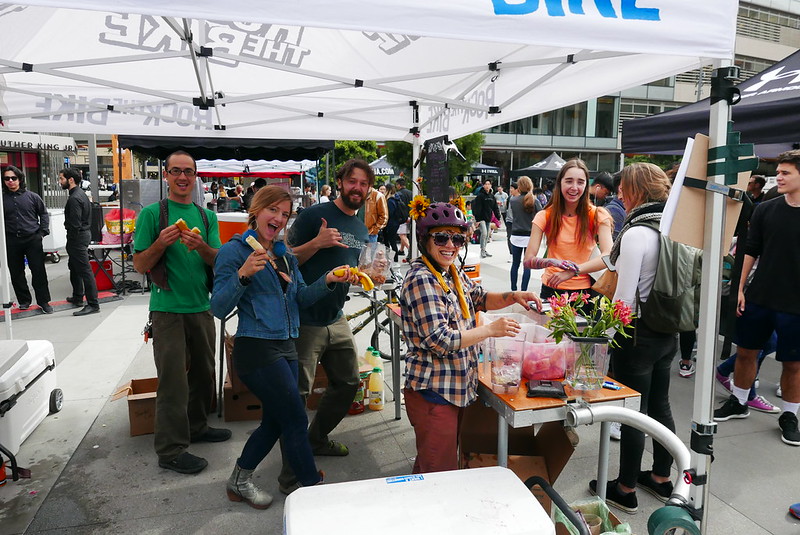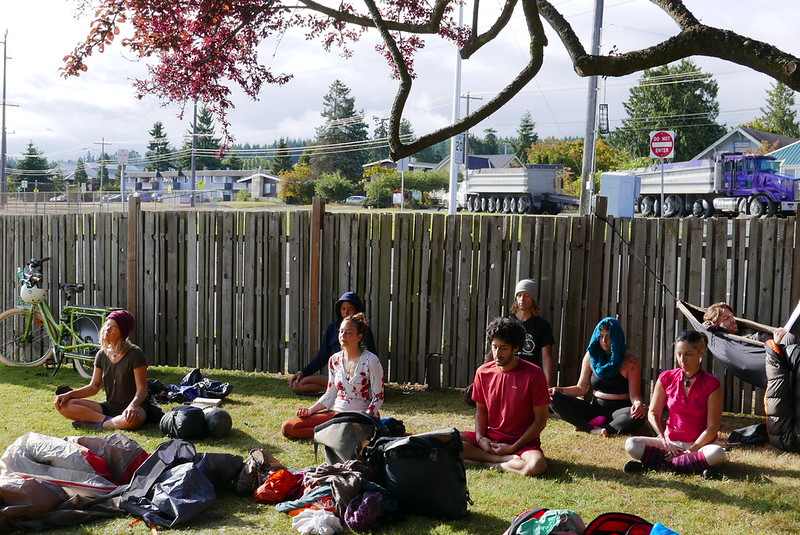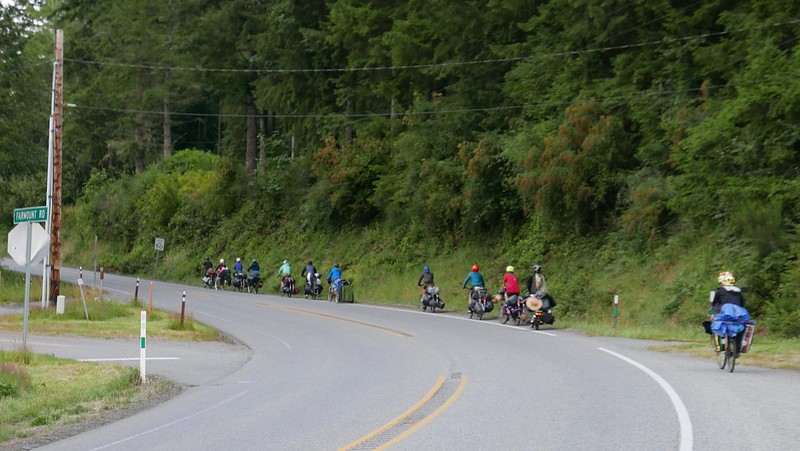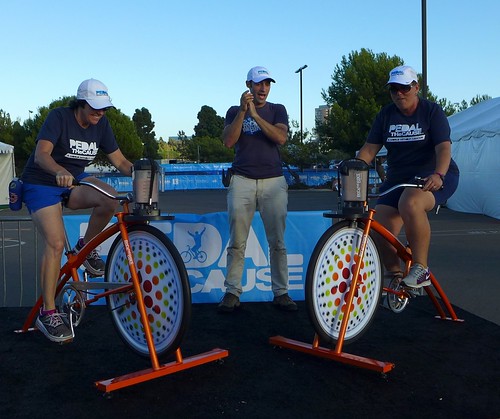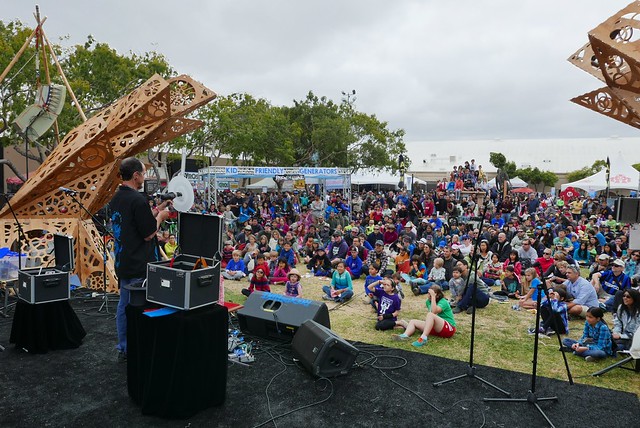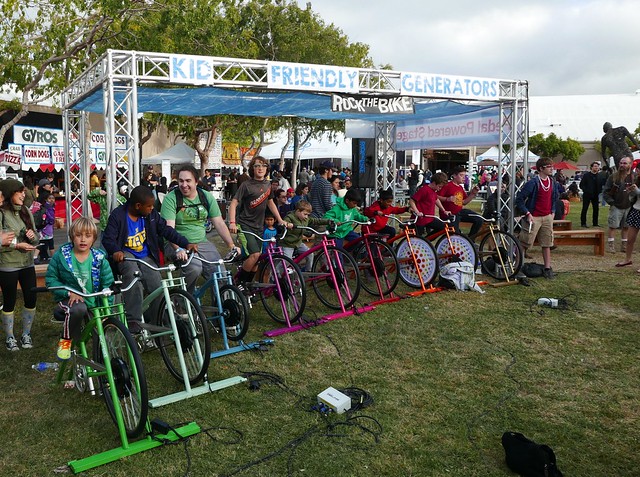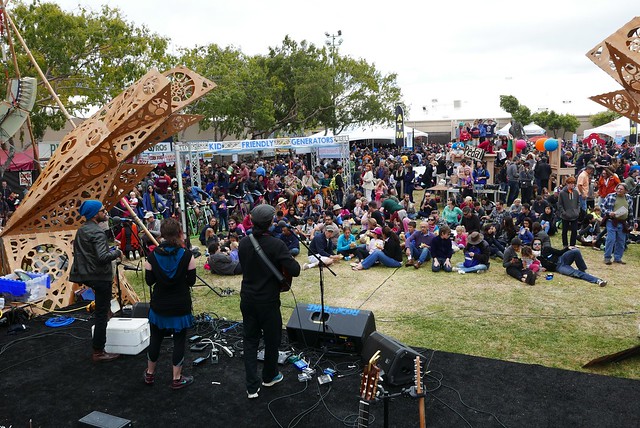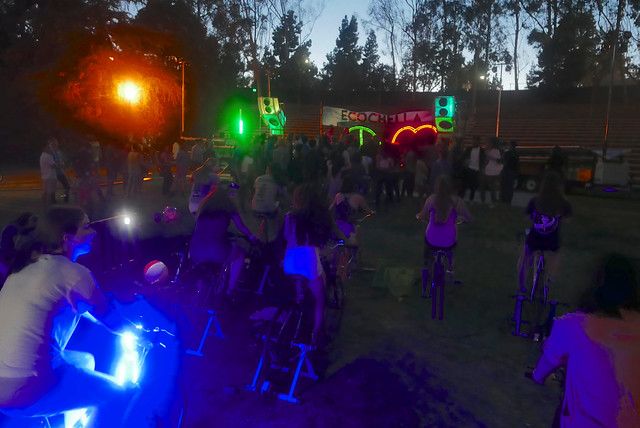A quality bike generator from Rock The Bike can be a serious — and seriously fun — component in your preparedness plan for upcoming Public Safety Power Shutoffs during this year’s fire season in Northern California, or any type of outage. While battery banks last for a while, and solar panels can refresh them during the sunny hours, only a quality bike generator allows you to contribute a targeted burst of energy whenever you need to. For years we promoted our pedal power gear for event activities, not for emergency preparedness, because the latter felt like a downer. Then we tried it. It’s fun, relatively quiet (compared to a gas generator), plus you get exercise and it’s a great learning lab!
In this post we’ll break down what to expect when designing a system, and how Pedal Power can fit into your existing system.
Backup systems can get expensive, so we’ll start off with some good news.
If you already have an existing off-grid solar system or you own a battery backup system, (commonly sold as “solar generators”or “power banks”), there’s a good chance you can connect Rock The Bike’s Roll Up DC generator stand to the 12V or 24V solar panel input. This is great news for anyone who wants to improve the performance and flexibility of their existing system and have some fun in the process. If you want the stability and looks of our Generator Pro, you can also use it, however, only with a 24V compatible input.
More good news: If you don’t have a battery system, you can now have a complete preparedness solution for well under $1000 with Off The Wall. Pedaling the Off The Wall will directly charge & power many devices including your communications without an additionaly battery backup. For under $2000, you can upgrade and go with Off The Wall Pro. How can a single bike generator power a house? It can’t. But neither can most of the battery or small solar systems on the market. In fact, having the right expectations and knowledge of what you’re going to be able to do is the key to emergency preparedness. It’s all about knowing what your goal is. If you set a modest but achievable preparedness goal, like keeping your communications gear powered up so you can coordinate with others, then a single quality bike generator can be a complete system.

Sandra uses the Roll Up Generator Stand to charge a battery bank, allowing lights and devices to be powered now and later.
Now the nitty gritty. What are some of goals you may have as you consider the possibility of an upcoming outage, and how can you hit them?
Said another way, if an outage happens and it threatens to be a long one, what devices would you want to stay on? Everyone’s situation is different, but we’ve identified 2 approachable preparedness goals that may resonate with you:
| Cost |
Goal |
Approach |
Features / Benefits |
| $ |
Never lose communications – charge phones, radios and laptops. (During the ‘public safety power outages’ of 2019, cell service continued while homes lost power) |
Off The Wall Generator Stand |
Extremely compact and doesn’t take much closet / garage space. About the size of a carry-on bag.
Simple! Directly connects to phone chargers with no intermediate circuits.
No battery to maintain.
Fun. You pedal, the phones light up and devices charge.
Portable. You can ride somewhere and help others by setting up a temporary power hub.
Educational. Feel the load as you pedal. Simultaneously charging more phones, laptops & devices gets harder to pedal. Upgrade to the Comparator Display to see the exact amount of power in Watts. |
| $$ |
Never lose communications |
Off The Wall Pro |
Same benefits as Off The Wall stand but you don’t have to supply a bike. Comes with everything. Frame fits kids and adults. Easily switches to bike blending. * Requires more space than Off The Wall stand. |
| $$ |
Never lose communications. Use low power devices when you’re not pedaling, like LED lights |
Roll Up DC Generator Stand + Small “power bank”. The leading brands are Goal Zero and Jackery |
Fairly compact & bike mobile. Your system now has 2 components and uses fairly little garage / closet space. With the battery storage you can pedal now, use energy later. Or you can keep your system charged from the wall, use up the energy, then pedal to recharge it. |
| $$$ |
Never lose communications. Use low power devices when you’re not pedaling, like LED lights |
Generator Pro + Small backup power box |
Same benefits as above but with our Pro frame that fits kids and adults. Easily expands to bike blending. * Requires more space than the Roll Up generator stand. Can still be moved around fairly easily if you purchase the trailer wheels. |
| $$$$ |
Keep your food fresh and maintain communications and have efficient lights on at night. |
1 or more Roll Up Generator Stands or Generator Pros +
Large backup system* such as Titan or Humless |
Depending on the system you purchase, this could still be relatively compact in terms of garage space, however it’s now going to be so heavy that you won’t want to carry it. Get exercise as you help charge your system. Use solar panels if you can. Once you start running a fridge, it will be less likely you’ll be able to keep up with your energy usage through pedal power alone. But you can prolong your battery. Even if all 4 people pedaled for an hour a day you wouldn’t keep up with the energy usage of a fridge. |
* Notes about keeping food fresh (bottom option in the table and biggest electrical load):
Your fridge probably uses 50W 24hrs a day on average, and this is within reach with a larger system. Larger backup systems have integrated inverters strong enough to run a fridge, and larger batteries that are measured in KiloWatt-hours or kWh. For each day of anticipated outage you’ll need roughly 1 kWh (1000Wh) of batteries.
Having a few small lamps with LED bulbs won’t change this, as you’ll only need them for a couple hours a day and they use little power.
A note on DIY. The larger you plan to build your system, the more you’ll save by going DIY. Here are some of the steps you’d go through.
To purchase:
- Large 48V lithium battery with integrated Battery Management System (BMS)
- Large 48V inverter rated at least 1500 Watts Pure Sine
- Wall charger with 100-240V input power rating
- Wiring
- Solar panels + charge controller
- Off The Wall or Off The Wall Pro
What’s the difference between this approach and an Off Grid Power system? The difference is that an Off Grid power system powers everything and a backup power system powers only a portion of your devices.
Can I do more than power just my fridge and a few lights? Yes. You can. The 2 goals identified above are the ones we think are relevant to most Rock The Bike readers. To set your own preparedness goals, you’ll want to start with a Kill A Watt and do your own energy audit. The Kill A Watt tells you the Wattage used by any device. Multiply by the number of hours per day that device will get used to find the energy required per day. If it’s something like a fridge that goes on/off/on/off all the time, use the Kill A Watt’s energy tracking mode to give you the info you need. Add all your daily device subtotals and multiply by the length of outage you want to be prepared for and that’s your big number. Then when you buy your battery, multiply again by 1.5 as batteries almost always under perform their ratings.
Confused? Want help? We do this stuff! Contact us for a free 20 minute consultation, which could lead to us designing or building a system for you or could just give you a greater handle on the most confusing parts of DIY.
Preparing for a major power outage will force you to understand which of your devices are using the most energy, a highly educational process. Adding a quality bike generator into your system makes it way more fun. It’s the difference between taking in numbers and understanding it in your body as you sweat and get a workout. An off-grid system is a learning lab for appreciating energy, and of course, if well-designed, it will help you get through outages. But during most of the year, when power is flowing bountifully from the power company to you, your system will still help you! For one thing you can reduce your bill and usage of dirty power by running some devices off your solar/Pedal Power system. Whenever you want one, you can get a workout in which your effort isn’t wasted in heat but collected in useful energy. And there’s another important way to save. You’ll be so much more connected to your energy usage, you’ll remember to turn devices off. So, even if power outages are only in effect for days each year, the awareness you’ll gain will result in real savings the rest of the year. Learnings from participating in your energy production can give you the knowledge you need to reduce your electricity bills, which will help pay back the equipment and make you a better steward of the environment.
Whatever strategy you choose for outage preparedness, devoting some freezer space to large frozen bottles of water will create a thermal battery that can slow down the thaw of your fridge. You can move the bottles from the freezer to fridge and keep your food fresh.


















